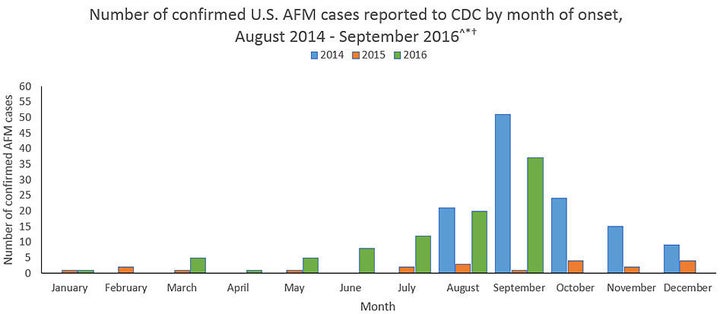
The U.S. Centers for Disease Control and Prevention is investigating the rise of a rare polio-like illness that tends to strike children.
Acute flaccid myelitis, a condition that affects the nervous system, has sickened 89 people across 33 states so far this year, and doctors aren’t sure what causes it.
Scientists still only have a preliminary understanding of how AFM affects children, but it appears to affect muscle tone, sometimes to the point of long-term paralysis.
Symptoms include sudden weakness in the limbs, loss of muscle strength and decreased reflexes. Other signs of the disease include droopy eyes, slurred speech, or difficulty swallowing. In particular, there’s a wide spectrum of muscle weakness, ranging from mild weakness in a single limb to almost complete paralysis in all four limbs, or a loss of the ability to breathe on one’s own.
One alarming complication is that AFM appears to be triggered by common viruses, which means that children can start off with fever and respiratory issues that can then develop into muscle weakness and other symptoms associated with AFM. Because of how AFM starts, parents may not get their children to the hospital on time to pinpoint a potential viral cause, said Dr. Kevin Messacar, a pediatric infectious disease physician and researcher at Children’s Hospital Colorado.
While it’s normal to take care of children at home with fluids, rest and relaxation for illnesses that appear to be a common cold or slight fever, parents should take their children to a healthcare provider at the first sign of muscle weakness, Messacar advises. A delay between a child’s first sign of muscle weakness and his or her first visit to the doctor makes it harder for doctors to identify a potential cause.
“By that time, many of the viruses that can trigger this would no longer be detectable,” he said. “The earlier that patients can present and get tested, the better chance we have to find a triggering infection.”
Even though it’s on the rise, acute flaccid myelitis is still extremely rare
It’s important to note that despite the spike in case reports, the condition is still exceedingly rare; less than one in one million people in America will experience it.
“This is a very rare condition, but it still is an important condition for the scientific community to learn more about, particularly because of the potential for long-term and disabling consequences,” said Messacar. “Even though there are very few cases in the country, as researchers and scientists, we need to move the field forward in order to better prevent and treat the condition.”
So far this year, the CDC has recorded 89 confirmed cases of AFM across 33 states, but this may be an undercount because reporting on the condition only started in 2014 and is voluntary in most states. The CDC counted 21 confirmed cases of AFM in 2015 and 120 cases from August 2014 to December 2014.

It’s unclear what causes acute flaccid myelitis
Experts aren’t sure what causes AFM, as scientists haven’t been able to consistently isolate a germ in a patient’s spinal fluid that could explain what triggered the condition.
They have found that it appears to be triggered by a variety of diseases, including viral infections like West Nile virus, Japanese encephalitis virus, the virus that causes polio and those that can cause the common cold, pneumonia, bladder infection or gastroenteritis.
Complicating matters is that doctors aren't sure how to treat a child once acute flaccid myelitis is present. Different doctors have attempted things like corticosteroids, antiviral medications and immune globulin therapy that infuses more antibodies into a patient. None have been shown to be effective.
Messacar, who helped treat 12 AFM patients in Colorado in 2014, observed that the majority of the patients had some kind of respiratory illness before their muscle weakness set in. What’s unique about this Colorado cluster is that half of them had one triggering virus in common: enterovirus D68, a non-polio enterovirus that causes severe respiratory illness, as opposed to the variety of viruses the CDC has identified as potential AFM triggers. Even one or two years after their AFM diagnosis, a majority of the patients still have muscle weakness or some kind of physical disability.
This outcome aligns with a June 2015 report on 111 AFM cases recorded across the U.S. before Feb. 2015. While recovery information for this group is incomplete, the researchers noted that 62 percent ended up partially improving, 37 percent had not improved and only one percent had completely recovered. However, the report doesn’t clarify what “partial improvement” means.
The CDC conducted a short-term follow-up survey on some of the 2014 AFM patients and found that a small number had completely recovered use of their limbs after a median of about four months. Another small number reported no improvement in limb strength. Most patients reported some improvement in muscle function, but it isn't clear how much.
How to lower your risk of acute flaccid myelitis
The best way to prevent the onset of AFM is virus prevention in general. That means being up to date on all your vaccines, including polio. Washing your hands after going to the bathroom, before touching food and after contact with a sick person or an open wound can help keep you safe against all germs, while mosquito bite prevention can protect you against West Nile Virus. If you are sick, staying home from work or school and covering the mouth and nose while sneezing and coughing is simply good infection control practice, Messacar notes.
